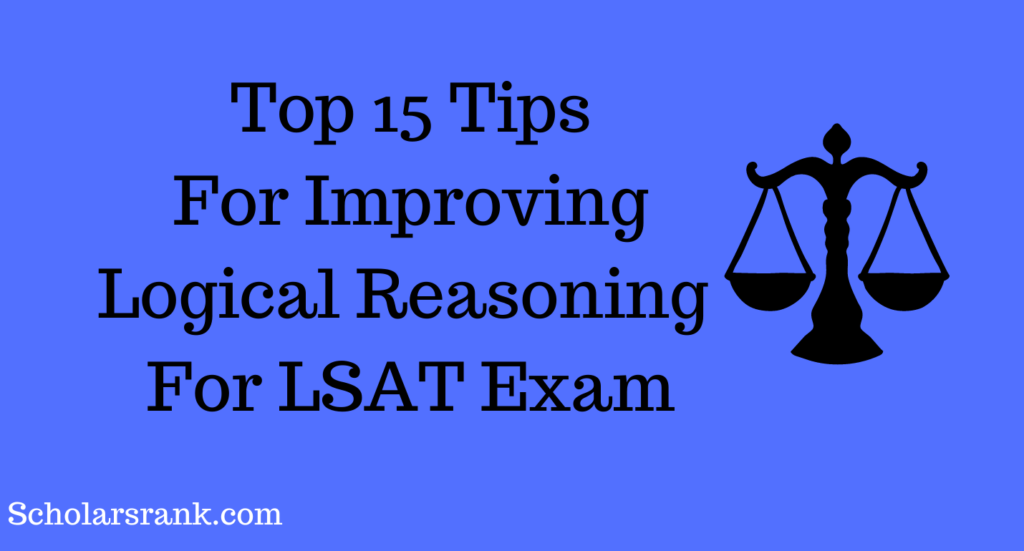Introduction
The LSAT exam is difficult, however, improving logical reasoning for LSAT exam is important. A high score might be the difference between receiving a scholarship and paying for law school out of pocket, not to mention being admitted to the school of your choice in the first place.
It is difficult to raise your score, however, the logical reasoning test portion is the greatest place to start. Why? since it determines 50% of your LSAT score.
However, you’ll need to dedicate a lot of time to preparing if you want to ace the LSAT’s logical reasoning exam. You’ll also need to work more efficiently rather than harder. So continue reading to discover the top logical reasoning advice for the LSAT. To assist you, we’ll go over nine(9) preparation tips and six (6) test-day tips that will guide you.
What is the LSAT?
The LSAT is a multiple-choice test with a skills component that assesses your readiness for law school. Unlike any other test you’ve ever taken in your academic career, the Law School Admission Test (LSAT) is unique.
It’s crucial to become familiar with the LSAT’s ins and outs before starting your prep so that you are ready for what will be covered on the test.
Three multiple-choice sections with scores, an experimental component without scores, and a writing sample submission without scores make up the LSAT.
Only the LSAT is recognized by all Canadian and American law schools that hold ABA accreditation. A strong LSAT score is often regarded as being the most crucial, even if some schools accept GRE scores in place of an LSAT score.
Preparation Tips For Improving Logical Reasoning For the LSAT Exam
We’ll go over a few study ideas before getting into test-day advice. You’ll be in serious trouble if you don’t prepare properly. Everyone has a distinct way of studying, but repetition is the key to success. Several methods exist for preparing for the logical reasoning segment of the exam.
- Take Practice Exams
You can get practice exams online and through LSAT prep courses. While some practice exams are free, some cost money. Nevertheless, since the questions on prior exams will be comparable to those on this year’s exam, we advise practicing with them. They will differ, but they will all be appropriately designed and prepare you for the kind of logical reasoning prompts you may encounter.
We advise creating a strict study routine to practice. You’ll be able to schedule specific study time each week in this manner. Make sure you take into account all of your prior duties before you begin. After that, allow yourself some downtime. The remaining time can be spent studying logical reasoning. Before moving on from a question or topic, always make sure you know it completely. You don’t want to be left wondering on test day.
- Time Yourself
The LSAT is about speed in many ways. So, be sure to time yourself when you take your practice exams. Given that you have only about 80 seconds to answer each question in the logical reasoning section, this is particularly crucial. Your performance on the actual test will be determined by timing yourself and watching how quickly you complete the logical thinking problems. You become accustomed to the pressure of working against the clock by placing yourself in timed situations.
If you don’t time yourself beforehand, you can find yourself falling far behind on the real LSAT. Your brain will begin to function at a specific rate once you develop the habit of timing your answers.
- Work Your Way Up to Full Sections
To put it mildly, the logical reasoning section is difficult. These questions are not just draining, but they also call for a certain amount of quick thinking and speed. To succeed on the LSAT, progressively advance to entire sections as you begin your preparation.
For instance, instead of giving oneself the challenging task of finishing the full section in the allotted time, try doing individual questions. As your speed increases, add more questions until you can practice entire sections in the allowed time. This not only makes the logical thinking section easier for you, but it can also make it less taxing.
- Build Up To Complete Parts Gradually.
Most people are unable to complete a marathon without ever having run before. For the problems requiring logical reasoning, the same principle applies. Even for those who have spent months studying, the portions can be extremely taxing. They demand mental agility and endurance, which can only be developed via training and repetition. Start with manageable sections of questions and eventually work your way up to a complete section. This not only makes studying appear less taxing but also avoids frustration by giving your mind time to become accustomed to the kind of logical framework these questions ask you to think about.
- Examine Your Responses To Determine Whether There Are Any Questions That You Have Trouble Answering.
Examine the questions you get wrong, and look for any patterns. You may have trouble answering a specific kind of question. If so, you might concentrate extra study on those particular issues. You might not realize that only one or two sorts of questions are difficult for you, though, if you don’t examine your responses.
- Prevent Burnout
Burnout is a problem that occurs far too frequently. Before the test, students cram in a few late-night study sessions and wind up exhausting themselves. Too much time spent studying has also been shown to be detrimental. It causes knowledge to be misremembered or not understood at all. This is the reason the 90-20 rule is advised.
- Keep Track Of Your Overall Score After Taking All Of The Required Components.
Throughout your preparation, keep a record or log of your performance on the logical reasoning portions. Keeping track of your progress as you study for the LSAT might help you understand how well your preparation is progressing. You’ll know you need to seek out further assistance if, over time, your scores do not rise.
- How to Apply the 90-20 Rule
The 90-20 guideline is straightforward: devote 90 minutes to researching the subject matter. Then, take a break for 20 minutes. During the break, you can do whatever you like, but it’s important to give your brain some time to rest.
- Peer-To-Peer Learning
One of the finest strategies to get ready for the LSAT’s logical reasoning part is to study with peers. If you can convince a peer of the validity of your reasoning, you have demonstrated your mastery of the subject. Because of this, studying alongside classmates is an excellent approach to being ready for the test.
We believe that a small group of four peers is the optimum size for this to function. This is because there are four separate prompts in the logical reasoning phase of the exam, each with a unique set of questions. So, a four-person group allows everyone to concentrate on a single prompt.
Although peer studying is beneficial, you shouldn’t do it every day. Make sure to schedule a few peer study sessions into your schedule, but also allot time to work through sample questions on your own. You shouldn’t be reluctant to invite a few friends or family members if you don’t have peers who are also studying for the LSAT. Anyone can help because the instructions don’t require any special knowledge to respond.
- Work with an LSAT Tutor
One of the best methods to improve your LSAT score is by working with a knowledgeable instructor. You can locate tutors with good availability, even during late hours, thanks to advances like video calling. There are several excellent private coaching options as well as excellent LSAT tutoring programs like LSATMax.
While working with a tutor might be helpful, you should make sure they are an excellent teacher. Verify the person’s LSAT score and area of expertise before working with them. For the logical reasoning portions of the exam, an instructor who primarily concentrates on writing examples is not a suitable fit, especially if they did not achieve a particularly high LSAT score.
Test Day Tips For Improving Logical Reasoning For the LSAT Exam
Although preparation is crucial for the LSAT’s logical reasoning part, it is only half the battle. You must give your all on test day if you want to perform well. Fortunately, we have some excellent advice you can put into practice.
- Choose the Right Question Type
Determine the type of question you are looking at in the first place. This is more challenging than it sounds because there are many different kinds of problems in the logical reasoning part. Here is a brief description of some of the inquiries you will encounter:
Strength/weakness: Identify logical faults in an argument or identify supporting evidence.
Assumption: Determine what the argument implies in the absence of facts.
Parallel Reasoning: Select a statement that is logically related to the argument using parallel reasoning.
Conclusion: Select a statement that offers an alternative interpretation of the argument.
- Find The Conclusion Of The Argument.
You need to be aware of the conclusions the argument is drawing to effectively respond to a logical reasoning inquiry. Although the conclusions of an argument are occasionally uncovered at its conclusion, they are typically hidden within. Once you’ve skimmed the prompt, take your time and hunt for words that indicate the answer.
The phrases “hence,” “consequently,” and “although” are a few of them. Usually, these phrases come out just before the argument is about to reach a big conclusion. The statement that concludes should then be circled.
Finding the solution is essential since it makes it easier to respond to queries. Instead of reading the question four or five times, you will only need to refer to one brief phrase.
- Search Keywords
You can get relevant information and get great hints from keywords. Unfortunately, a logical reasoning issue can use a lot of terms as keywords. However, there are some excellent strategies to distinguish between keywords and filler terms.
Look for words that start a phrase or statement to get started. Words like “few,” “sometimes,” “many,” “unless,” and “this” are examples of them. Usually, these phrases signal the introduction of pertinent data. From there, you should circle any words that support the argument. So keep an eye out for important information like places, names, things, living things, and numbers.
Move on to the questions and replies where you’ll want to perform the same thing once you’ve identified the significant words in the argument. Any keywords you identify in the questions and answers should be underlined. As a result, you can make quick connections between the question, the answer, and the prompt.
- Discover the False Solutions First
There are multiple-choice questions in the section on logical reasoning. The fact that you don’t have to write any answers down is excellent, but it comes at the cost of receiving several incorrect responses. Finding the correct response is trickier than you might think because some of the responses will be similar and just differ by a few words.
Therefore, eliminate any incorrect responses first. There will be a few incorrect answers, so mark those off and continue. Then, attentively and several times read the remaining answers. Before removing a response, make sure you fully grasp what it is recommending.
Last but not least, be sure the response you select is the best. Unfortunately, there is more than one right response to some logical reasoning problems. You must choose the one that makes the most sense in light of this. You shouldn’t make any unsupported assumptions in your response or have any obvious errors.
- Keep Your Pace
The LSAT is all about pace, along with quickness. Making sure you’re answering the questions quickly enough is essential to your success because the logic reasoning exam is divided into two pieces. However, it is simpler said than done. You must read through a lot of brief prompts in the logic reasoning portion because questions may now include fresh material. Your timed study during the practice exams will be useful in this situation.
First and foremost, stop focusing on the time. You waste every second you spend checking the time. Furthermore, if you can’t think of the appropriate answer, don’t think about a question for too long. Nobody likes passing up opportunities, but with the LSAT, You occasionally have to accept what you can get. If you’re stuck, eliminate some of the possibilities and guess. Keep on since each question awards the same number of points.
- Read each option.
Some preparation programs instruct students to read the material and the question stem, guess an answer, and then select their response following their prediction. While the approach might work if you’re short on time, it has a significant problem. Degrees of truth are discussed in the LSAT’s logical reasoning section. Two technically accurate answers to a question are frequently available, and they may only differ slightly in a phrase. If you don’t read every choice, you could not even read the right response and instead select the “almost right” one.
You have plenty of time to read the passage, the question stem, and each alternative before making your decision because each question is given roughly 80 seconds. If you have time remaining in a section you have previously finished, you cannot move on to another one on the LSAT. Therefore, why not take the entire time allotted for the logical reasoning sections to ensure that you have considered all of your options and chosen the best one?
Conclusion
Focus and perseverance are necessary tips on how to improve on the LSAT’s logical reasoning parts. You want to adopt a balanced strategy, ensuring that you are ready for exam day and capable of answering the questions truthfully. Additionally, you want to maximize your time. Don’t be scared to move on if you don’t know the answer to a question.
Make sure you use these suggestions on the day of the test. It’s critical to calm any lingering fears and begin the exam with confidence. To calm yourself down if you start to feel nervous throughout the test, start breathing exercises. Your life will be challenging if your thoughts are out of control.
The good news is that this advice on logical thinking will be useful. You’re positioning yourself for success both during test preparation and on test day by following advice like this. So, maintain your composure, stay on task, and get ready to take the logical reasoning part to the task.
Frequently Asked Questions (FAQs)
Is It Possible To Develop Logical Reasoning Skills?
Asking questions about things you ordinarily take for granted is one of the finest methods to improve your capacity for logical thought. Asking questions also helps broadens your perspective, allowing you to think more clearly and creatively about difficulties at work.
What Is The LSAT’s Purpose?
Admission to law school depends heavily on the LSAT. The LSAT is designed to evaluate the abilities needed for first-year law school success.
You can also read Best undergraduate degree for Medical school in Canada.








